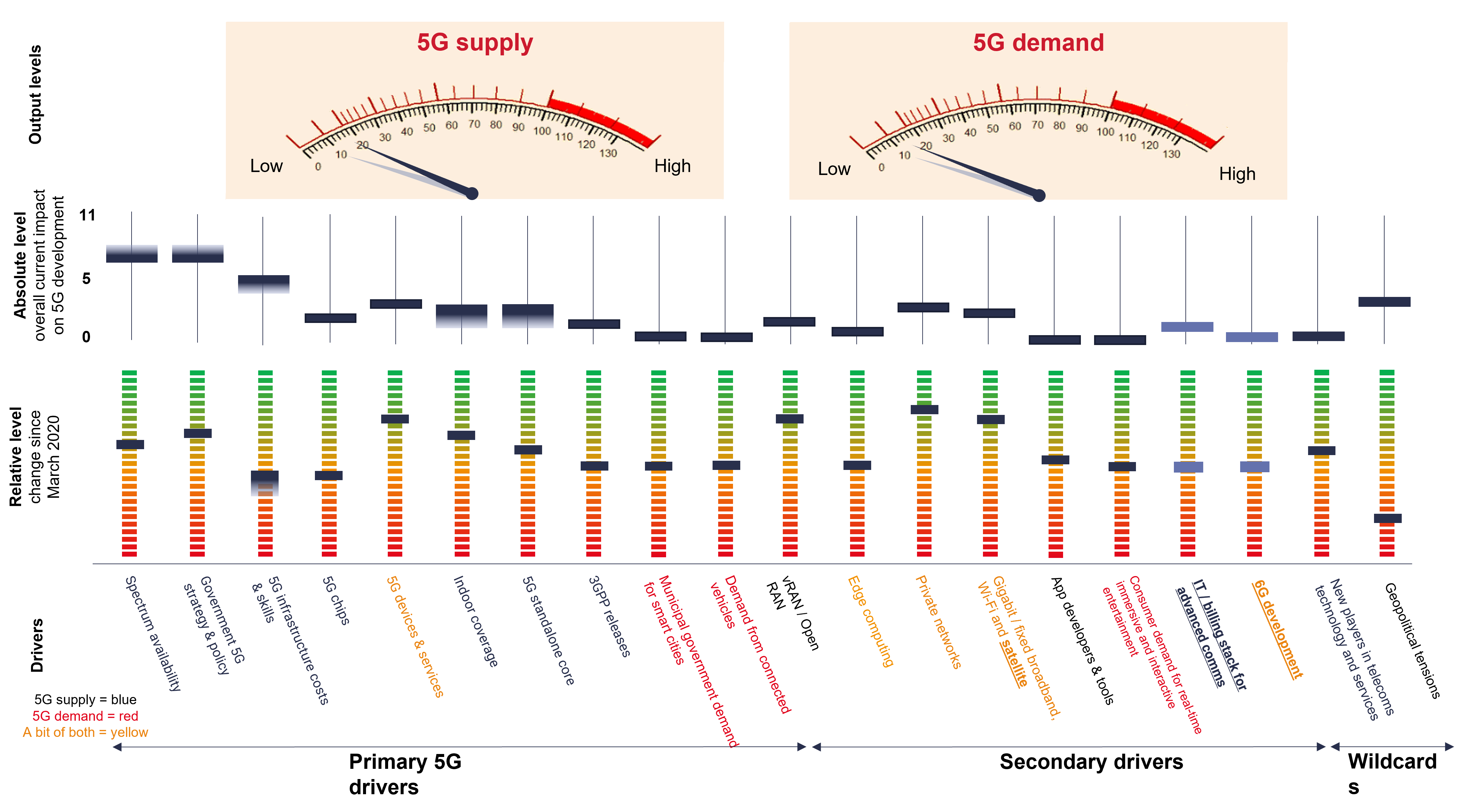5G-aliser July 2021 Update: Can telcos launch new services without standalone 5G? – Total Telecom
Introducing new factors
• This quarter we dropped COVID-19 and 5G conspiracy theories in the wildcards factors, as these have largely stabilised and are less relevant than newly emerging ones
• The first new addition is the IT / billing stack for advanced communications
• 6G is the second new factor, seeing increasing interest and investment around the world
• We also retitled ‘US/China tradewar and other geopolitical issues’ to ‘Geopolitical tensions’, which better reflects the multi-faceted regional tensions affecting 5G development, ranging from security to competitive dynamics in network equipment and software…
Introducing new factors
• This quarter we dropped COVID-19 and 5G conspiracy theories in the wildcards factors, as these have largely stabilised and are less relevant than newly emerging ones
• The first new addition is the IT / billing stack for advanced communications
• 6G is the second new factor, seeing increasing interest and investment around the world
• We also retitled ‘US/China tradewar and other geopolitical issues’ to ‘Geopolitical tensions’, which better reflects the multi-faceted regional tensions affecting 5G development, ranging from security to competitive dynamics in network equipment and software, as well as net neutrality
Over a year into tracking 5G development, the bottom line remains that the disruptive and innovative elements of 5G are not possible without a standalone core and reliable indoor coverage. This is reflected in the results of the 5G-aliser analysis, where supply has increased from 10% to 19% y-o-y to July 2021, but demand has grown more slowly from 10% to 16%, mostly due to progress in factors that affect both supply and demand, rather than from purely demand-side factors (shown in red).
Another key enabling factor is implementation of next generation billing IT stacks that can handle much more dynamic, flexible and modular connectivity services. For example, leading Asian operator we spoke with is leveraging its 5G network to offer premium connectivity services, including a gaming optimiser solution for consumers, but its billing platform is the main roadblock to being able to commercialise some of them.
Although MWC didn’t bring too many real industry breakthrough announcements, TelcoDR’s $100mn investment in upstart billing platform Totogi did make a splash are illustrative of the growing importance of the billing IT stack to monetisation of 5G services. STL Partners’ analysts are sceptical that an AI-infused billing platform that can adjust rates in accordance to a telco’s local market dynamics will raise ARPUs significantly, but the ability to bill for services in a more flexible and modular way will soon be table stakes for telcos.

Until the technology matures, 5G services will remain limited
Telcos’ ideas of what they want to do are starting to crystalise, but actual 5G services beyond cloud, early edge, and FWA are not convincing.
Key points of consideration in services are:
• AR/VR: Some telcos are making bets here, experimenting with some initiatives, but nothing at scale. Orange, NTT Docomo, China Mobile are the biggest experimenters, while BT doing also launched an AR service in its sports app.
• 5G devices: There is a risk that semi-conductor chip shortages will impact some devices. This is could hit high value devices such as smartphones, but is more likely to filter down to lower cost IoT sensors or in V2X communications. Aside from the chip shortage, the other challenge with 5G devices is that few (or none) of them are compatible with all spectrum bands
• Moving from premium to mass market: Some telcos (e.g. Telstra – see STL Partners’ profile) have taken a premium approach to 5G services, but don’t have a clear strategy for how to adapt from a premium to a mass market strategy for consumers
[embedded content]
Catch the highlights of our 5G-aliser discussion, featuring Total Telecom, STL Partners and Disruptive Analysis
Addressing the infrastructure and skills costs
Finally, and linking back to the question of 5G standalone cores and network coverage, many movements in the industry are fundamentally about overcome infrastructure costs and skills shortages.
• Huawei, Ericsson and Nokia are all making noise about their sub-20kg 5G base stations. This is important because the lower weight means that a single engineer can install the base station instead of needing to hire a crane.
• AT&T’s deal with Microsoft and DISH’s deal with AWS – both are about how to address the cost of network technology development at scale. AT&T has been a huge proponent of a DIY approach to developing its NFV / SDN technology. However, its deal with Microsoft suggests that it was reaching an inflection point, where it is potentially beginning to compete with major vendors. While it has built up a very large software team, realistically it can’t compete with global vendors? By offloading its Network Cloud technology to Microsoft, AT&T is securing much more significant funds and skills to scale its work. The ultimate question is that if AT&T judges that it cannot truly be its own software player, is it viable for any other telco?
How is the deployment of standalone 5G changing 5G services? Find out how the operators are managing the new technology at this year’s live Total Telecom Congress
Also in the news:
MTN Nigeria to pump $1.5bn into broadband
Water, electricity, gas and…internet? Colombia names the web an essential service
Arianespace launches pair of telecoms satellites
*** This article has been archived for your research. Find the original article here ***


